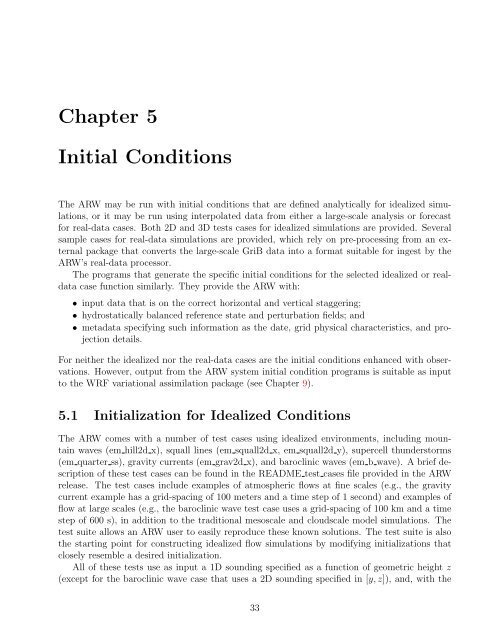Advanced Research WRF (ARW) Technical Note - MMM - University ...
Advanced Research WRF (ARW) Technical Note - MMM - University ...
Advanced Research WRF (ARW) Technical Note - MMM - University ...
Create successful ePaper yourself
Turn your PDF publications into a flip-book with our unique Google optimized e-Paper software.
Chapter 5<br />
Initial Conditions<br />
The <strong>ARW</strong> may be run with initial conditions that are defined analytically for idealized simulations,<br />
or it may be run using interpolated data from either a large-scale analysis or forecast<br />
for real-data cases. Both 2D and 3D tests cases for idealized simulations are provided. Several<br />
sample cases for real-data simulations are provided, which rely on pre-processing from an external<br />
package that converts the large-scale GriB data into a format suitable for ingest by the<br />
<strong>ARW</strong>’s real-data processor.<br />
The programs that generate the specific initial conditions for the selected idealized or realdata<br />
case function similarly. They provide the <strong>ARW</strong> with:<br />
• input data that is on the correct horizontal and vertical staggering;<br />
• hydrostatically balanced reference state and perturbation fields; and<br />
• metadata specifying such information as the date, grid physical characteristics, and projection<br />
details.<br />
For neither the idealized nor the real-data cases are the initial conditions enhanced with observations.<br />
However, output from the <strong>ARW</strong> system initial condition programs is suitable as input<br />
to the <strong>WRF</strong> variational assimilation package (see Chapter 9).<br />
5.1 Initialization for Idealized Conditions<br />
The <strong>ARW</strong> comes with a number of test cases using idealized environments, including mountain<br />
waves (em hill2d x), squall lines (em squall2d x, em squall2d y), supercell thunderstorms<br />
(em quarter ss), gravity currents (em grav2d x), and baroclinic waves (em b wave). A brief description<br />
of these test cases can be found in the README test cases file provided in the <strong>ARW</strong><br />
release. The test cases include examples of atmospheric flows at fine scales (e.g., the gravity<br />
current example has a grid-spacing of 100 meters and a time step of 1 second) and examples of<br />
flow at large scales (e.g., the baroclinic wave test case uses a grid-spacing of 100 km and a time<br />
step of 600 s), in addition to the traditional mesoscale and cloudscale model simulations. The<br />
test suite allows an <strong>ARW</strong> user to easily reproduce these known solutions. The test suite is also<br />
the starting point for constructing idealized flow simulations by modifying initializations that<br />
closely resemble a desired initialization.<br />
All of these tests use as input a 1D sounding specified as a function of geometric height z<br />
(except for the baroclinic wave case that uses a 2D sounding specified in [y, z]), and, with the<br />
33
















